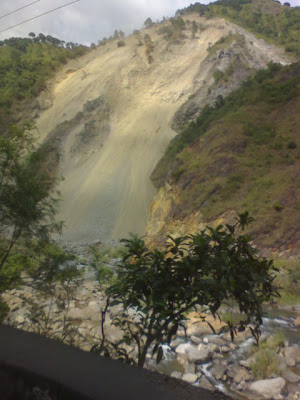Foggy Afternoon in Baguio
Sunday, July 27, 2008 at 1:07 AM Posted by Ryan Mendoza
Labels: Baguio, Philippines, Tourist Destination 0 comments
Beautiful Clouds in Baguio
at 12:56 AM Posted by Ryan Mendoza
Labels: Baguio, Philippines, Tourist Destination 0 comments
The Lion King
Friday, July 25, 2008 at 9:43 PM Posted by Ryan Mendoza
Labels: Animal, Baguio, Philippines, Tourist Destination 0 comments
So Beautiful Cliffs
at 9:30 PM Posted by Ryan Mendoza
See my blog archives for more pictures.
Labels: Baguio, Mountains, Philippines, Tourist Destination 1 comments
Cliff
at 9:14 PM Posted by Ryan Mendoza
Labels: Baguio, Mountains, Philippines, Tourist Destination 0 comments
So in LOVE
at 8:30 PM Posted by Ryan Mendoza
Labels: Clouds, Heaven, Philippines 0 comments
Sunset
at 8:27 PM Posted by Ryan Mendoza
Labels: Clouds, Heaven, Philippines 0 comments
The Beautiful Sun
at 8:19 PM Posted by Ryan Mendoza
Labels: Clouds, Heaven, Philippines, Sun 0 comments
Global Warming Causes Glacier to Grow
Thursday, July 24, 2008 at 10:21 PM Posted by Ryan Mendoza

 The glaciers on Mount Shasta in California are growing because of global warming, experts say.
The glaciers on Mount Shasta in California are growing because of global warming, experts say.
"When people look at glaciers around the world, the majority of them are shrinking," said Slawek Tulaczyk, a University of California, Santa Cruz, professor who studied the glaciers.
But the seven glaciers on Shasta, part of the Cascade mountains in northern California, "seem to be benefiting from the warming ocean," he said.
As the ocean warms, more moisture evaporates. As moisture moves inland, it falls as snow — enough on Shasta to more than offset a 1 C temperature rise in the past century.
The three smallest of the Shasta glaciers are more than twice the length they were in 1950.
Other glaciers in Norway, Sweden, New Zealand and Pakistan were in the same position as Shasta, but are now shrinking because rising temperatures have more than offset the increased snowfall.
As many as 90 per cent of Earth's mountain glaciers are getting smaller, said Lonnie Thompson from Ohio State University.
A U.S. government inventory found that, with one exception, Shasta's glaciers are the only ones growing on the U.S. mainland, said Andrew Fountain, a professor at Portland State University, who worked on the assessment.
The exception is a small glacier that is shaded in the crater of Mount St. Helens, Wash. It's unlikely to continue to grow once it leaves the shade, scientists said.
Four glaciers on the shady north and east sides of Mount Rainier, Wash., are stable.
Labels: California, International, Mountains, Water 0 comments
The Beauty of Tubbataha Reefs
at 10:20 PM Posted by Ryan Mendoza
The name 'Tubbataha' is the Samal word for "long reef exposed at low tide". Samals are seafaring people of the Sulu Sea and are one of the few people who have accessed the Park in early 1980's. Cagayanen people who are more geographically associated with Tubbataha Reefs referred the Park as ‘gusong’. Tubbataha Reefs Natural Park (TRNP) lies in the middle of the Sulu Sea and falls under the political jurisdiction of Cagayancillo, an island municipality situated 130km to the north. The park is around 150km south-east of Puerto Princesa City - capital of the Province of Palawan - the usual jump-off point for visitors and dive boats going to Tubbataha.
Tubbataha Reefs Natural Park (TRNP) lies in the middle of the Sulu Sea and falls under the political jurisdiction of Cagayancillo, an island municipality situated 130km to the north. The park is around 150km south-east of Puerto Princesa City - capital of the Province of Palawan - the usual jump-off point for visitors and dive boats going to Tubbataha.
The reef is composed of two atolls, North and South Reefs. Each reef has a single small islet that protrudes from the water. The atolls are separated by a deep channel 8 km (5 miles) wide. 
Tubbataha Reefs Natural Park is home to some of the most beautiful coral reefs in the world. Rising from the volcanic depths of the Sulu Sea in the western Philippines, these magnificent atolls encompass an astonishing diversity of marine life.
The park is an underwater sanctuary where nature can thrive. Tubbataha is the Philippines' only National Marine Park and is also a UNESCO World Heritage Site, a place of global importance, being preserved for generations to come.
From majestic whale sharks to elusive seahorses - Tubbataha supports an unparalleled variety of marine creatures. Colourful reef fish crowd corals growing in the shallows while sharks and manta rays haunt the steep drop offs to the open sea. 
A team of rangers are stationed on the reef year-round and, from March until June, divers visit Tubbataha to experience the wonders of this unique underwater world.
To view gallery of Tubbataha click here.
The Manila city council passed a resolution that urged Filipinos to vote online for the Tubbataha Reef in Palawan as one of the "New Seven Wonders of Nature"?
Labels: Palawan, Philippines, Water 0 comments
The Nature of Puerto Princesa
at 10:13 PM Posted by Ryan Mendoza
PUERTO PRINCESA CITY, Palawan-- Palawan derived its name from the very shape of the island. It is shaped like an umbrella hence "Paragua" (Spanish) or "Pa-lao-you" (Chinese). It has a total area of 1,703,075 has. and 1,780 islands and islets.
Successful enforcement of the city's ban on compressor fishing (City Ordinance No. 267) was found to result in an over-all improvement in coral cover, including an increase in number, species and size of fish and other indicator species, such as the priced suno.This was the finding of a marine resource assessment (MRA) in the 234-hectare Manyukos Island Marine Sanctuary (MIMS) last August 24 in Purok Mangingisda, Barangay Buenavista, Puerto Princesa City. The over-all conditions of the seagrass and coral reef ecosystems of the MIMS were assessed and compared to data from a 2003 MRA. Members of the MRA team, led by the Samahan ng Maliliit na Mangingisda ng Buenavista (SAMMABU) and assisted by the young fishermen of Buenavista, ELAC and student volunteers,found that the ban had relieved the threat of overfishing in the sanctuary.The nine species of seagrass in Buenavista remain intact but are showing signs of stress due to erosion from upland kaingin, construction, and pollution from a nearby fishpond of the Watchers Multi-purpose Cooperative, which continues to operate despite the lack of required permits.Meanwhile, an MRA done for the 174-hectare Tabang Cove Marine Sanctuary in Barangay. Sta. Cruz, also in the city, revealed that both corals and seagrass have been extensively damaged and overfished due to triple-net fishing and abalone gathering. Most of the massive corals have been either broken or overturned by fishermen collecting abalone from underneath the corals. The findings alarmed the Tabang Cove Sanctuary Management Board (SMB), which immediately passed a barangay ordinance that included the launching of a more aggressive information and education campaign to generate support from the adjacent barangays of Salvacion, Manalo and Tagburos, whose residents frequent the area for fishing. The SMBs of both sanctuaries are now expected to give higher priority to regular sanctuary monitoring after the MRA results were presented to them. Monitoring activities include the deployment of additional buoys and the construction of a guardhouse.
In Memorandum Circular No. 129, Series of 2002, issued by the Secretary of the Department of Interior and Local Government, local chief executives and sanggunians were enjoined to enact local ordinances banning the use of compressor fishing as fishing apparatus in all fishing activities because of its hazardous effects which resulted to death and paralysis.
Because compressor fishing allows fishermen to go down to depths of more than a hundred feet, improper ascents can result in decompression
 sickness or “bends”, the effects of which range from headaches and dizziness to paralysis and death. Compressors are also usuallly used in cyanide and dynamite fishing, both of which cause overfishing and the destruction of coral reefs.
sickness or “bends”, the effects of which range from headaches and dizziness to paralysis and death. Compressors are also usuallly used in cyanide and dynamite fishing, both of which cause overfishing and the destruction of coral reefs.Moreover; a light mist of saltwater spray cools my face, as the barka, a motorized outrigger, makes its way across the placid sea. Below the water surface, coral reefs are visible with the naked eye. The water is teeming with marine life, just waiting to be discovered by lucky scuba divers and snorkelers. We run parallel to a coast, covered in thick green jungle. The peak of St. Paul’s mountain rises high above the undisturbed beauty of the rainforest.
And because of the patience and urge of the community of Puerto Princesa, it is now the most "Cleanest and Greenest City in the Philippines". In addition to that, it is one the candidate for the new seven wonders of the world (Subterranean National Park) along with Tubbataha Reef (Sulu), Chocolate Hills (Bohol), and Mount Mayon (Albay). To vote, just log on to http://www.new7wonders.com/ .
Labels: Animal, Palawan, Philippines, Water 0 comments
SEARCH
About Me
Labels
- Animal (3)
- Baguio (5)
- Batangas (2)
- California (1)
- Clouds (5)
- Dove (1)
- Fish (1)
- Heaven (5)
- International (3)
- Makati (1)
- Marine Life (1)
- Mountains (4)
- My Pictures (2)
- Palawan (2)
- Philippines (18)
- Sea (5)
- Sun (7)
- Tourist Destination (6)
- Trees (2)
- Trip (7)
- Volcano (1)
- Water (9)
- Zamboanga (5)
My Blog List
-
TNC PREDATOR'S BEST PLAYS AT ESL ONE HAMBURG 2019 - TNC PREDATOR is your next TI Champion Watch TNC's performance at ESL One Hamburg held at Hamburg, Germany as they try to snatch the Aegis. Thank you for ...6 years ago
-
Hopkins Versus Pavlik - ATLANTIC CITY, N.J. (AP)—Bernard Hopkins gave Kelly Pavlik a boxing lesson and a first loss that he will never forget. The 43-year-old Hopkins used lightn...17 years ago












































